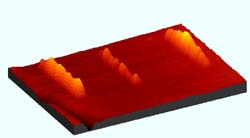New technique for DNA nanostructures

DNA nanostructures <br>© University of California - Davis <br>
A new method to make very small patterns of DNA molecules on surfaces has been developed by chemists at the University of California, Davis, and Wayne State University, Detroit. The technique could allow faster and more powerful devices for DNA sequencing, biological sensors and disease diagnosis.
The technique, called nanografting, can be used to make patterns of DNA that are up to a thousand times smaller than those in commercially available microarrays, said UC Davis chemist Gang-yu Liu. Liu developed the method with Christine Chow at Wayne State University and UC Davis graduate students Maozi Liu and Nabil Amro.
“We believe these are the smallest nanostructures of DNA yet made,” Liu said. They drew lines as small as 15 nanometers across by 150 nanometers long — equivalent to eight DNA molecules across. The same method can be applied to make structures as small as two by four nanometers, or a few billionths of an inch, in size.
Microarrays — arrangements of small dots of DNA or other molecules on slides or chips — have become a powerful tool in biomedical research. For example, a DNA array can be used to look at thousands of genes in a cell at the same time and see which are switched on or off.
The patterns are made by coating a gold film with long, closely-packed molecules called thiols. The thiols attach to the gold through a sulfur atom at one end and stand upright. The researchers use an atomic force microscope probe — essentially a very fine needle — to scrape away some of the thiols. They add short pieces of DNA, called oligonucleotides, which have thiols attached at one end. The thiols stick the DNA onto the exposed gold head-first, leaving the rest of the DNA standing up above the thiol layer.
The researchers showed that the DNA molecules were accessible and chemically active. The research is published in the August 2002 issue of the journal Nano Letters
Media Contact
More Information:
http://www.ucdavis.edu/All latest news from the category: Life Sciences and Chemistry
Articles and reports from the Life Sciences and chemistry area deal with applied and basic research into modern biology, chemistry and human medicine.
Valuable information can be found on a range of life sciences fields including bacteriology, biochemistry, bionics, bioinformatics, biophysics, biotechnology, genetics, geobotany, human biology, marine biology, microbiology, molecular biology, cellular biology, zoology, bioinorganic chemistry, microchemistry and environmental chemistry.
Newest articles

Superradiant atoms could push the boundaries of how precisely time can be measured
Superradiant atoms can help us measure time more precisely than ever. In a new study, researchers from the University of Copenhagen present a new method for measuring the time interval,…

Ion thermoelectric conversion devices for near room temperature
The electrode sheet of the thermoelectric device consists of ionic hydrogel, which is sandwiched between the electrodes to form, and the Prussian blue on the electrode undergoes a redox reaction…

Zap Energy achieves 37-million-degree temperatures in a compact device
New publication reports record electron temperatures for a small-scale, sheared-flow-stabilized Z-pinch fusion device. In the nine decades since humans first produced fusion reactions, only a few fusion technologies have demonstrated…





















